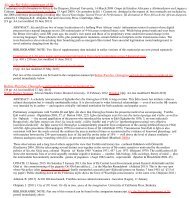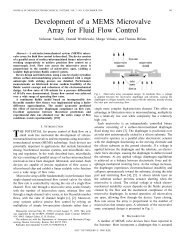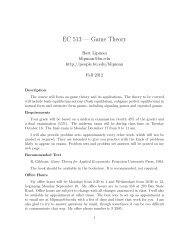CUP2 binds in a bipartite manner to upstream activation sequence c ...
CUP2 binds in a bipartite manner to upstream activation sequence c ...
CUP2 binds in a bipartite manner to upstream activation sequence c ...
You also want an ePaper? Increase the reach of your titles
YUMPU automatically turns print PDFs into web optimized ePapers that Google loves.
452<br />
Deletion studies have shown that UASc is required<br />
for copper-<strong>in</strong>duced transcription of the CUP1 gene [12,<br />
13]. Initially, specific <strong>CUP2</strong>-DNA <strong>in</strong>teractions were exam<strong>in</strong>ed<br />
by mutagenesis of UASc. Individual transition<br />
mutants with<strong>in</strong> this region of the CUP1 promoter (positions<br />
–105 <strong>to</strong> –148 relative <strong>to</strong> the transcription start site)<br />
were constructed and assayed for transcriptional activity<br />
[5]. All mutants that were completely non<strong>in</strong>ducible<br />
were found <strong>in</strong> a 16-bp region <strong>in</strong> the <strong>upstream</strong> half of<br />
UASc. In the downstream half of UASc, no mutants<br />
were completely non<strong>in</strong>ducible, although some mutants<br />
were substantially less <strong>in</strong>ducible than the wild-type construct.<br />
These results led Hamer and coworkers [5] <strong>to</strong><br />
propose that the 16-bp region <strong>in</strong> the <strong>upstream</strong> half of<br />
UASc is a potential b<strong>in</strong>d<strong>in</strong>g site for <strong>CUP2</strong>.<br />
Further biochemical analysis of the mode of b<strong>in</strong>d<strong>in</strong>g<br />
of <strong>CUP2</strong> has revealed that <strong>CUP2</strong> <strong>in</strong>deed <strong>b<strong>in</strong>ds</strong> <strong>to</strong> both<br />
halves of UASc. A variant <strong>CUP2</strong> prote<strong>in</strong>, called ace1,<br />
<strong>in</strong> which a s<strong>in</strong>gle cyste<strong>in</strong>e residue is substituted by tyros<strong>in</strong>e,<br />
<strong>b<strong>in</strong>ds</strong> <strong>to</strong> DNA but is <strong>in</strong>capable of <strong>in</strong>duc<strong>in</strong>g transcription.<br />
Exam<strong>in</strong>ation of the specific <strong>in</strong>teractions made<br />
by <strong>CUP2</strong> and ace1 with DNA <strong>in</strong>dicated that the DNAb<strong>in</strong>d<strong>in</strong>g<br />
doma<strong>in</strong> of <strong>CUP2</strong> is complex, be<strong>in</strong>g composed<br />
of two or more elements that recognize dist<strong>in</strong>ct features<br />
of UASc [14].<br />
We report here the results of hydroxyl radical footpr<strong>in</strong>t<strong>in</strong>g<br />
[15] and miss<strong>in</strong>g nucleoside experiments [16]<br />
for <strong>CUP2</strong> or ace1 bound <strong>to</strong> a restriction fragment conta<strong>in</strong><strong>in</strong>g<br />
UASc. Us<strong>in</strong>g these methods we have determ<strong>in</strong>ed<br />
which nucleotides are protected or contacted by<br />
the two prote<strong>in</strong>s. We show that ace1 contacts a smaller<br />
region of the <strong>upstream</strong> half-site of UASc, consistent<br />
with previously published experiments [14, 17]. Our results<br />
provide further evidence that the DNA-b<strong>in</strong>d<strong>in</strong>g<br />
doma<strong>in</strong> of <strong>CUP2</strong> is complex, composed of multiple elements<br />
that recognize dist<strong>in</strong>ct features of UASc. In addition,<br />
our studies suggest that the disparity <strong>in</strong> the effect<br />
on transcription of mutations <strong>in</strong> the two half-sites of<br />
UASc is likely <strong>to</strong> be due <strong>to</strong> differences <strong>in</strong> the <strong>in</strong>teractions<br />
of <strong>CUP2</strong> with each half-site.<br />
Materials and methods<br />
Plasmids, DNA molecules and prote<strong>in</strong>s<br />
Plasmid pUASc, conta<strong>in</strong><strong>in</strong>g the 5b-noncod<strong>in</strong>g region of the CUP1<br />
gene from positions –145 <strong>to</strong> –105, was the source of the DNA<br />
used <strong>in</strong> these experiments. DNA restriction fragments were radiolabeled<br />
at either the 5b or 3b end of the H<strong>in</strong>dIII site, digested<br />
with EcoRI, and purified by gel electrophoresis. The prote<strong>in</strong>s<br />
used were expressed <strong>in</strong> and purified from Escherichia coli transformed<br />
with plasmid pET7<strong>CUP2</strong>, pET7<strong>CUP2</strong>TR, or pET7ace1,<br />
as described previously [14].<br />
B<strong>in</strong>d<strong>in</strong>g conditions for the <strong>CUP2</strong>-DNA complex<br />
B<strong>in</strong>d<strong>in</strong>g solutions conta<strong>in</strong>ed 0.05–0.10 ng s<strong>in</strong>gly end-labeled 94-bp<br />
restriction fragment that conta<strong>in</strong>ed UASc from the CUP1 promoter<br />
(100000–200000 dpm), 1 mg BSA, 1% polyv<strong>in</strong>yl alcohol,<br />
20 ng poly(dI7dC), 12.5 mM Hepes-NaOH (pH 8), 50 mM KCl,<br />
6.25 mM MgCl2, 0.5 mM EDTA, 0.5 mM DTT, and 0–500 ng<br />
<strong>CUP2</strong> prote<strong>in</strong>, <strong>in</strong> a <strong>to</strong>tal volume of 20 ml. The solution was <strong>in</strong>cubated<br />
on ice for 15 m<strong>in</strong>.<br />
Hydroxyl radical foot pr<strong>in</strong>t<strong>in</strong>g<br />
The hydroxyl radical cleavage reaction was performed as previously<br />
described [15, 18]. The sample conta<strong>in</strong><strong>in</strong>g the prote<strong>in</strong>-<br />
DNA complex was warmed <strong>to</strong> room temperature for 1 m<strong>in</strong>, and<br />
then the cutt<strong>in</strong>g reagents were added. The f<strong>in</strong>al concentrations of<br />
cutt<strong>in</strong>g reagents were 1 mM Fe(II), 2 mM EDTA, 0.003% H 2O 2,<br />
and 20 mM sodium ascorbate. After 2 m<strong>in</strong> the reaction was s<strong>to</strong>pped<br />
by addition of thiourea <strong>to</strong> a f<strong>in</strong>al concentration of 24 mM.<br />
DNA was precipitated twice by addition of ethanol, r<strong>in</strong>sed, dried<br />
under vacuum, resuspended <strong>in</strong> 3 ml of formamide-dye mixture,<br />
heated <strong>to</strong> 90 7C for 5 m<strong>in</strong>, and electrophoresed on a denatur<strong>in</strong>g<br />
gel (12% polyacrylamide, 8.3 M urea). The gel was dried, au<strong>to</strong>radiographed,<br />
and scanned with a Joyce-Loebl Chromoscan 3 densi<strong>to</strong>meter.<br />
Miss<strong>in</strong>g nucleoside experiment<br />
Miss<strong>in</strong>g nucleoside experiments were performed as previously described<br />
[16]. The DNA molecule used was a 94-bp restriction<br />
fragment conta<strong>in</strong><strong>in</strong>g UASc from the CUP1 promoter. Gapped<br />
DNA conta<strong>in</strong><strong>in</strong>g UASc was produced by add<strong>in</strong>g 12 ml of each of<br />
the hydroxyl radical-generat<strong>in</strong>g reagents <strong>to</strong> a sample conta<strong>in</strong><strong>in</strong>g<br />
approximately 1.5 ng s<strong>in</strong>gly end-labeled DNA (3000000 dpm) <strong>in</strong><br />
60 ml of 10 mM Tris-HCl buffer (pH 8.0), 1 mM EDTA. F<strong>in</strong>al concentrations<br />
of the cleavage reagents were 1 mM Fe(II), 2 mM<br />
EDTA, 0.003% H2O2, and 20 mM sodium ascorbate. The reaction<br />
was allowed <strong>to</strong> proceed for 2 m<strong>in</strong> at room temperature and then<br />
s<strong>to</strong>pped by addition of 30 ml of 0.1 M thiourea. The DNA was<br />
precipitated with ethanol, r<strong>in</strong>sed, and dried.<br />
Mobility shift assay<br />
<strong>CUP2</strong> or ace1 was bound <strong>to</strong> UASc by add<strong>in</strong>g prote<strong>in</strong> <strong>to</strong> a solution<br />
conta<strong>in</strong><strong>in</strong>g approximately 0.25–0.5 ng of radiolabeled gapped<br />
DNA (500000–1 000000 dpm), 1 mg BSA, 1% polyv<strong>in</strong>yl alcohol,<br />
20 ng poly(dI!dC), 12.5 mM Hepes-NaOH (pH 8), 50 mM KCl,<br />
6.25 mM MgCl2, 0.05 mM EDTA, and 0.5 mM DTT, <strong>in</strong> a <strong>to</strong>tal volume<br />
of 10 ml. The mixture was <strong>in</strong>cubated on ice for 15 m<strong>in</strong>,<br />
warmed <strong>to</strong> room temperature, and then 2 ml of 30% glycerol was<br />
added. To separate prote<strong>in</strong>-bound DNA from free DNA, samples<br />
were loaded on an 8% nondenatur<strong>in</strong>g gel (80:1 acrylamide:bis).<br />
Electrophoresis was performed at room temperature at 125 V for<br />
3 h <strong>in</strong> a buffer consist<strong>in</strong>g of 25 mM Tris-borate-HCl (pH 8.3), and<br />
2.5 mM EDTA. The wet gel was au<strong>to</strong>radiographed for 1 h. The<br />
desired bands were excised from the gel and crushed. DNA was<br />
eluted by soak<strong>in</strong>g the crushed gel slice <strong>in</strong> buffer [50 mM ammonium<br />
acetate, 1 mM EDTA (pH 6.5)] at 37 7C overnight. DNA was<br />
precipitated with ethanol twice, r<strong>in</strong>sed, dried, resuspended <strong>in</strong> 3 ml<br />
of formamide-dye mixture, heated <strong>to</strong> 90 7C for 5 m<strong>in</strong>, and electrophoresed<br />
on a denatur<strong>in</strong>g gel (10% polyacrylamide, 8.3 M urea).<br />
Results<br />
Hydroxyl radical footpr<strong>in</strong>t<strong>in</strong>g<br />
The hydroxyl radical footpr<strong>in</strong>ts of the ace1 mutant prote<strong>in</strong>,<br />
<strong>in</strong> which Cys11 is substituted by Tyr, are presented<br />
<strong>in</strong> Fig. 1. These hydroxyl radical footpr<strong>in</strong>ts are virtually<br />
identical <strong>to</strong> those of the wild-type <strong>CUP2</strong> prote<strong>in</strong> bound







